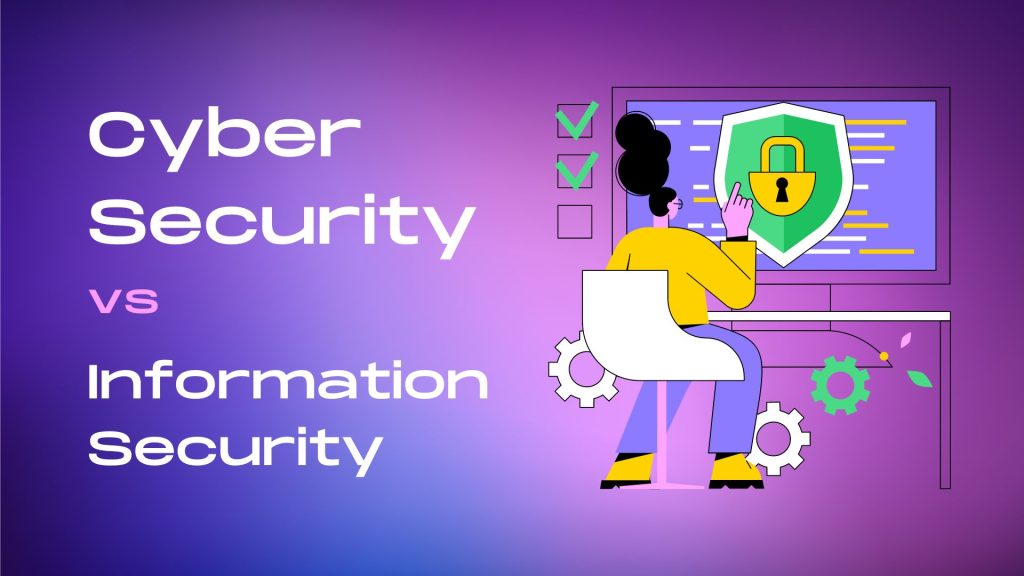Cybersecurity vs Information Security: What’s the Difference?

The two terms “cybersecurity” and “information security” may seem like interchangeable terms, but they have subtle differences.
Both refer to a broad field that focuses on protecting devices and networks from cyberattacks. However, there are some key differences between these two terms.
Table Comparison: Cybersecurity vs Information Security
Remember that while there are distinctions between Cybersecurity and Information Security, the terms are often used interchangeably, and the specific focus of these fields can vary based on context and organization. But here’s a table comparison that describes the nuances between them.
| Aspect | Cybersecurity | Information Security |
|---|---|---|
| Scope | Focuses on protecting digital systems, networks, and data from cyber threats. | Encompasses the protection of information in all its forms, including physical, digital, and intellectual property. |
| Nature of Threats | Primarily deals with threats from cyberspace, including hacking, malware, and cyberattacks. | Addresses a broader range of threats, such as physical theft, unauthorized access, social engineering, etc. |
| Technology Emphasis | Heavily technology-centric, involving IT systems, networks, encryption, and firewalls. | Emphasizes a holistic approach, covering people, processes, policies, and technologies. |
| Digital Focus | Primarily concerned with digital data, systems, and networks. | Covers both digital and non-digital information, including paper documents, personnel, and physical assets. |
| Scope of Protection | Focuses on protecting against attacks and breaches in the digital realm. | Encompasses protection of sensitive information and assets across various contexts. |
| Terminology | Often uses terms like “cyber threats,” “cyberattacks,” and “hacking.” | Uses terms like “confidentiality,” “integrity,” “availability,” and “risk management.” |
| Prevention and Defense | Primarily aims to prevent cyberattacks and protect digital assets. | Aims to secure information from unauthorized access, loss, or damage through various measures. |
| Incident Response | Involves responding to cyber incidents, containing threats, and recovering systems. | Encompasses responding to various security incidents, not limited to cyber incidents. |
| Regulation and Compliance | Often influenced by specific cyber regulations and standards. | Compliance with broader regulations related to data protection, privacy, and industry standards. |
| Skillset | Requires expertise in network security, cryptography, penetration testing, etc. | Requires knowledge in risk management, policy development, physical security, and legal aspects. |
| Cross-Disciplinary | Overlaps with IT security, network security, and computer science. | Integrates multiple fields, including legal, HR, physical security, and IT. |
| Examples | Encompasses the protection of sensitive information and assets across various contexts. | Implementing access controls, securing premises, and safeguarding sensitive information. |
| End Goal | Ensures the security of digital assets, data, and technology infrastructure. | Ensures the confidentiality, integrity, and availability of all types of information. |
What is cybersecurity?

Cybersecurity focuses on prevention and resilience against threats in the devices, networks, and systems that connect people, businesses, and government agencies to each other and the rest of the world.
A cybersecurity solution protects against cybersecurity threats, and it also improves overall device and network performance and security.
It includes the practice of protecting computer systems, networks, and data from unauthorized access, use, disclosure, disruption, modification, or destruction.
What is information security?
Information security is critical for organizations and individuals to protect sensitive information and maintain the integrity and trustworthiness of their systems and data.
Information security involves a wide range of practices, including encryption, access control, firewalls, antivirus software, intrusion detection and prevention, and security awareness training.
These practices are implemented to safeguard data and systems from cyber threats, such as malware, phishing attacks, and social engineering tactics.
Differences between cybersecurity and information security
Cybersecurity is the practice of protecting computer systems and networks from unauthorized access, use, or destruction. Information security, on the other hand, is the practice of protecting the confidentiality, integrity, and availability of information.

The biggest difference between the two is that cybersecurity focuses on protecting the system as a whole, while information security protects the data within the system.
Another important difference between cybersecurity and information security is that cybersecurity is a practice that is focused on stopping attacks, while information security is a practice focused on preventing unauthorized access, misuse, or disclosure of information.
Cybersecurity also encompasses physical security measures, such as firewalls and intrusion detection/prevention software, while information security typically refers to measures such as encrypted communication and data storage.
Conclusion
Overall, cybersecurity and information security are both important practices that need to be taken into account when protecting computer systems and networks.
Both account for the protection of devices, networks, and systems from threats in order to maintain the confidentiality, integrity, and availability of data and services.
In general, information security focuses on protecting data and information within an organization, while cybersecurity focuses on protecting data and information across multiple organizations or devices.



Related Cybersecurity
What Is IP Spoofing?
How To Train Your Employees in Cybersecurity
What Is a Botnet?
What Is a Rootkit Attack?
What is a Distributed Denial-of-Service (DDoS) Attack?
5 Reasons to Consider a Career in Cybersecurity
What Is DNS Spoofing?
3 Key Skills To Be a Cybersecurity Analyst